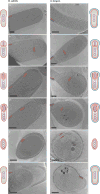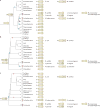Sporulation, bacterial cell envelopes and the origin of life
- PMID: 28232669
- PMCID: PMC5327842
- DOI: 10.1038/nrmicro.2016.85
Sporulation, bacterial cell envelopes and the origin of life
Abstract
Electron cryotomography (ECT) enables the 3D reconstruction of intact cells in a near-native state. Images produced by ECT have led to the proposal that an ancient sporulation-like event gave rise to the second membrane in diderm bacteria. Tomograms of sporulating monoderm and diderm bacterial cells show how sporulation can lead to the generation of diderm cells. Tomograms of Gram-negative and Gram-positive cell walls and purified sacculi suggest that they are more closely related than previously thought and support the hypothesis that they share a common origin. Mapping the distribution of cell envelope architectures onto a recent phylogenetic tree of life indicates that the diderm cell plan, and therefore the sporulation-like event that gave rise to it, must be very ancient. One explanation for this model is that during the cataclysmic transitions of the early Earth, cellular evolution may have gone through a bottleneck in which only spores survived, which implies that the last bacterial common ancestor was a spore.
Conflict of interest statement
The authors declare no competing interests.
Figures




Comment in
-
Comment on Tocheva et al. "Sporulation, bacterial cell envelopes and the origin of life".Nat Rev Microbiol. 2016 Sep;14(9):600. doi: 10.1038/nrmicro.2016.113. Epub 2016 Jul 25. Nat Rev Microbiol. 2016. PMID: 27452228 No abstract available.
-
Author's reply.Nat Rev Microbiol. 2016 Sep;14(9):600. doi: 10.1038/nrmicro.2016.114. Epub 2016 Jul 25. Nat Rev Microbiol. 2016. PMID: 27452232 No abstract available.
References
-
- Gram C. Ueber die isolirte firbung der schizomyceten iu schnitt-und trockenpriparate. Fortschitte Med. 1884;2:185–189. (in German)
-
- Sutcliffe IC. A phylum level perspective on bacterial cell envelope architecture. Trends Microbiol. 2010;18:464–470. - PubMed
-
- Martin W, Baross J, Kelley D, Russell MJ. Hydrothermal vents and the origin of life. Nat Rev Microbiol. 2008;6:805–814. - PubMed
Publication types
MeSH terms
Substances
Grants and funding
LinkOut - more resources
Full Text Sources
Other Literature Sources

